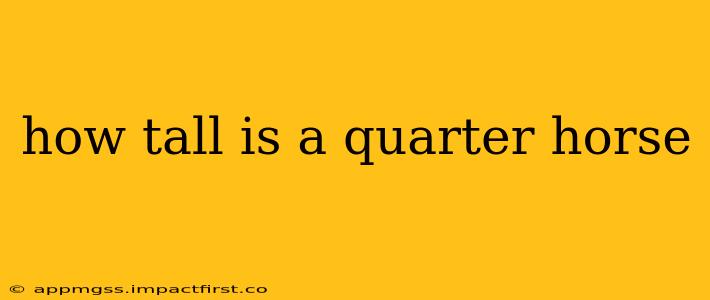Quarter Horses are known for their versatility and athleticism, making them popular choices for various disciplines, from racing and roping to pleasure riding and showing. But one of the first questions many people have is: how tall is a Quarter Horse? The answer isn't a single number, as there's considerable variation in their height. Let's delve into the details.
What is the Average Height of a Quarter Horse?
The average height of a Quarter Horse is between 14.2 and 16 hands high. One hand equals four inches, so this translates to approximately 56 to 64 inches or 4.7 to 5.3 feet tall at the withers (the highest point of the horse's shoulder). However, it's important to remember that these are just averages.
Are There Different Sizes of Quarter Horses?
Yes, there's significant variation in the size of Quarter Horses. While the average falls within the 14.2 to 16 hands range, you can find individuals that are slightly shorter or taller. Several factors contribute to this size variation:
-
Genetics: Like humans, a horse's genes play a significant role in determining its final height. Breeding practices can influence the size of the offspring, with some bloodlines consistently producing larger horses than others.
-
Nutrition: A horse's diet has a substantial impact on its growth and development. Horses that receive adequate nutrition during their growth phase are more likely to reach their full genetic potential. Conversely, poor nutrition can lead to stunted growth.
-
Sex: Generally, geldings (castrated males) tend to be slightly larger than mares (females), although this difference isn't always significant.
What is Considered a Small or Large Quarter Horse?
While the average height provides a useful benchmark, it's not a rigid classification. A Quarter Horse standing at 14 hands might be considered on the smaller side, while one at 16.2 hands would be considered on the larger end of the spectrum. However, horses at both extremes can still be perfectly healthy and conformationally sound.
How Does Height Relate to Quarter Horse Performance?
Height isn't the sole determinant of a Quarter Horse's performance capabilities. Other factors such as muscle mass, conformation, training, and temperament all play crucial roles. However, height can indirectly influence performance in certain disciplines. For example, taller horses might have a slight advantage in disciplines requiring longer strides, while shorter horses may excel in agility and maneuverability.
What is the Height Range for a Quarter Horse Used for Racing?
While there isn't a strict height requirement for Quarter Horse racing, smaller, more compact horses are often favored for their speed and quick acceleration.
What is the Height Range for a Quarter Horse Used for Ranch Work?
For ranch work and roping, a slightly taller horse might be preferred by some riders because of increased visibility and strength. However, again this is often a matter of rider preference and style.
In Conclusion:
The height of a Quarter Horse is variable, with the average ranging from 14.2 to 16 hands. Factors like genetics, nutrition, and sex contribute to this variation. While height can influence performance in some disciplines, it’s only one factor among many that contributes to a horse's overall capabilities. Understanding this variation is crucial for anyone interested in owning or working with these versatile and beloved horses.
